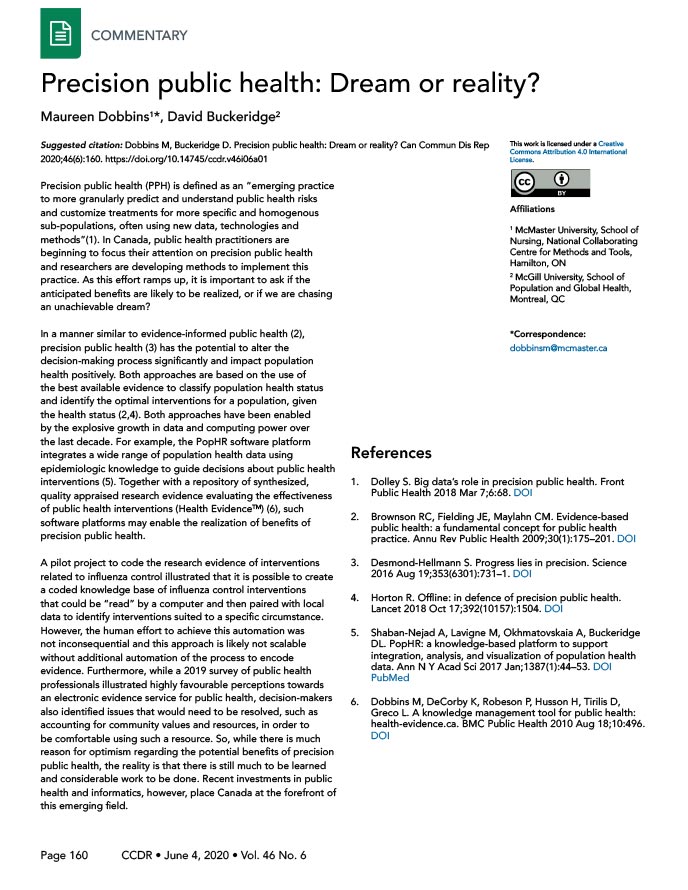An emerging practice to understand public health risks

 Download this article as a PDF
Download this article as a PDFPublished by: The Public Health Agency of Canada
Issue: Volume 46–6: Artificial intelligence in public health
Date published: June 4, 2020
ISSN: 1481-8531
Submit a manuscript
About CCDR
Browse
Volume 46–6, June 4, 2020: Artificial intelligence in public health
Commentary
Precision public health: Dream or reality?
Maureen Dobbins1, David Buckeridge2
Affiliations
1 McMaster University, School of Nursing, National Collaborating Centre for Methods and Tools, Hamilton, ON
2 McGill University, School of Population and Global Health, Montreal, QC
Correspondence
Suggested citation
Dobbins M, Buckeridge D. Precision public health: Dream or reality? Can Commun Dis Rep 2020;46(6):160. https://doi.org/10.14745/ccdr.v46i06a01
Precision public health (PPH) is defined as an “emerging practice to more granularly predict and understand public health risks and customize treatments for more specific and homogenous sub-populations, often using new data, technologies and methods”Footnote 1. In Canada, public health practitioners are beginning to focus their attention on precision public health and researchers are developing methods to implement this practice. As this effort ramps up, it is important to ask if the anticipated benefits are likely to be realized, or if we are chasing an unachievable dream?
In a manner similar to evidence-informed public healthFootnote 2, precision public healthFootnote 3 has the potential to alter the decision-making process significantly and impact population health positively. Both approaches are based on the use of the best available evidence to classify population health status and identify the optimal interventions for a population, given the health statusFootnote 2Footnote 4. Both approaches have been enabled by the explosive growth in data and computing power over the last decade. For example, the PopHR software platform integrates a wide range of population health data using epidemiologic knowledge to guide decisions about public health interventionsFootnote 5. Together with a repository of synthesized, quality-appraised research evidence evaluating the effectiveness of public health interventions (Health Evidence™)Footnote 6, such software platforms may enable the realization of benefits of precision public health.
A pilot project to code the research evidence of interventions related to influenza control illustrated that it is possible to create a coded knowledge base of influenza control interventions that could be “read” by a computer and then paired with local data to identify interventions suited to a specific circumstance. However, the human effort to achieve this automation was not inconsequential and this approach is likely not scalable without additional automation of the process to encode evidence. Furthermore, while a 2019 survey of public health professionals illustrated highly favourable perceptions towards an electronic evidence service for public health, decision-makers also identified issues that would need to be resolved, such as accounting for community values and resources, in order to be comfortable using such a resource. So, while there is much reason for optimism regarding the potential benefits of precision public health, the reality is that there is still much to be learned and considerable work to be done. Recent investments in public health and informatics, however, place Canada at the forefront of this emerging field.
